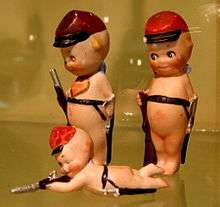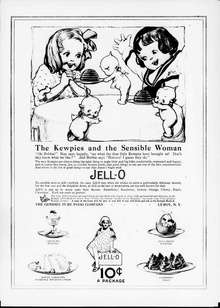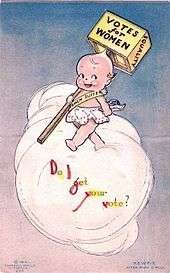Kewpie
Kewpie is a brand of dolls and figurines that were conceived as comic strip characters by cartoonist Rose O'Neill. The illustrated cartoons, appearing as baby cupid characters, began to gain popularity after the publication of O'Neill's comic strips in 1909, and O'Neill began to illustrate and sell paper doll versions of the Kewpies. The characters were first produced as bisque dolls in Waltershausen, Germany, beginning in 1912, and became extremely popular in the early 20th century.[1]
 Original German-made bisque Kewpie, c. 1912 | |
| Type | Doll, figurine |
|---|---|
| Inventor(s) | Rose O'Neill |
| Company |
|
| Country | United States |
| Availability | 1912–present |
| Materials | Bisque, composition, celluloid, rubber, plastic |
The Kewpie dolls were initially made out of bisque exclusively, but composition versions were introduced in the 1920s, and celluloid versions were manufactured in the following decades. In 1949, Effanbee created the first hard plastic versions of the dolls, and soft rubber and vinyl versions were produced by Cameo Co. and Jesco between the 1960s and 1990s.
The earlier bisque and composition versions of Kewpie dolls are widely sought-after by antique and doll collectors, who especially want those hand-signed by O'Neill. Kewpies should not be confused with the baby-like Billiken figures that debuted in 1908.[2]
Background and history

Rose O'Neill, a Midwest native who had worked as a writer and illustrator in New York City, initially conceptualized the Kewpie as a cartoon intended for a comic strip in 1909. According to O'Neill, the idea for the Kewpies came to her in a dream.[3] The comic, featuring the cherub-faced characters, was first printed in Ladies' Home Journal in the December 1909 issue.[4] O'Neill described the characters as "a sort of little round fairy whose one idea is to teach people to be merry and kind at the same time."[4] Their name, often shortened to Kewpies, derives from Cupid, the Roman god of erotic love.[5] After the characters gained popularity among both adults and children, O'Neill began illustrating paper dolls of them, called Kewpie Kutouts.[6]
O'Neill produced a Sunday comic strip for newspapers starting December 2, 1917, syndicated by the McClure Syndicate. The strip ended nine months later, on July 28, 1918.[7] She produced a second Sunday strip starting November 25, 1934, and that version lasted until February 6, 1937.[7]
Production
German bisque: 1912–1915


As demand for the Kewpie characters increased, Geo. Borgfeldt & Co. in New York contacted O'Neill in 1912 about developing a line of dolls and figurines. O'Neill agreed, and J.D. Kestner, a German toy company located in Waltershausen, set forth to manufacture small bisque dolls of the Kewpies. After the company manufactured the first run of dolls, they sent samples to O'Neill, who disapproved of the design because she felt they "did not look like her characters."[1]
O'Neill traveled to Germany and had the company destroy the moulds of the dolls, and oversaw the final redesign of them, working with a 17-year-old art student named Joseph Kallus.[1][6] The dolls were then released in nine different sizes, ranging from 1 to 12 inches (25–305 mm) in height. These early Kewpies wore a heart-shaped decal on their chests, which read "Kewpie, Germany", and some had jointed arms.[2] Many of these original German Kewpies were signed by O'Neill herself, and some were featured in various poses.
The small dolls became an international hit, and by 1914, O'Neill had become the highest-paid female illustrator in the country,[4] garnering a small fortune from the wild popularity of the dolls.[8] The Kewpie brand soon became a household name, and was used widely in product advertising, including promotion for Jell-O, Colgate, Kellogg's Corn Flakes, and Sears.[2] The Kewpies also appeared as a brand on a multitude of household items and other memorabilia, such as dishware, rattles, soap, pepper shakers, coloring books, poetry collections, and stationery.[9]
O'Neill also famously used the characters to promote the women's suffrage movement, using the illustrations in slogans and cartoons.[10]
Composition and celluloid: 1916–1930s
After World War I began in Europe, production of the bisque Kewpie dolls moved from Germany to France and Belgium, due to rising tensions after the assassination of Archduke Franz Ferdinand. Around this time, the dolls also began to be produced in the United States, made of composition material rather than bisque, due to bisque's fragility. The manufacturers also began to increase the sizes of the dolls, producing 22-inch (560 mm) versions in addition to the 12-inch (300 mm) versions. The American composition dolls also had the distinctive heart-shaped decal on the chest, reading "Kewpies, des. & copyright by Rose O'Neill." Like the original bisque models, some of the composition Kewpies were also hand-signed by O'Neill, and they all included jointed arms.
In the mid-1920s, small-sized celluloid versions of Kewpies appeared, and were often given out as prizes at carnivals.[11] Many of the celluloid versions were mainly manufactured in Japan, unlicensed, and were of a lower quality than other Kewpies. During this time, many Kewpies were sold with clothing, as well.
Later models: 1944–present
As photographs became more commonplace in advertising, the prominence of Kewpies in the marketing circuit began to wane. O'Neill returned to Missouri, where she died purportedly impoverished of complications from a series of strokes in 1944.[8] Despite the lessening in popularity, Kewpies continued to be manufactured for the majority of the century, including hard plastic versions, as well as all-bisque replicas of the original Kewpies, produced by Jesco and Cameo Co. in the 1960s until the 1990s.[12] These reproduction Kewpies lack the heart-shaped decal that distinguishes the original, older versions.
Collectibility
According to 200 Years of Dolls (fourth edition), a 10-inch Kewpie with a bisque head, composition body, and glass eyes today is worth $6,500, while a 20-inch (510 mm) doll is valued at $20,000.[6] Many of the original, small-sized German-produced bisque Kewpies (circa 1912-1915) range from $200–$500 among collectors.[13] Composition Kewpies range from $100–$300,[14] while celluloid versions (especially unlicensed Japanese reproductions) are worth considerably less. Kewpies that were hand-signed by Rose O'Neill (most often etched on their arms or feet) are much rarer than unsigned Kewpies.
In popular culture

- To "win a kewpie doll" is a common English idiom in the US, meaning that one has won a modest prize.
- This idiom is used in numerous fictional works, including Get Smart, The Monkees, Atlantis: The Lost Empire, Buffy the Vampire Slayer, Law and Order: SVU, and The Outsider.
- In season 3 episode 5 of Seinfeld, "The Library", the Library Cop Bookman refers to the librarian Kramer is involved with as "Kewpie doll".
- The Kewpie doll is the mascot of Kewpee Hamburgers, a chain of fast-food restaurants founded in 1923 in Flint, Michigan, by Samuel V. Blair under the name Kewpee Hotel Hamburgs.
- Since 1927, it has also been the mascot of Hickman High School in Columbia, Missouri.
- A song titled "Kewpie Doll" was written by Sid Tepper and Roy C. Bennett in the 1950s. The song was recorded by Perry Como and Frankie Vaughan in 1958 and became a hit in both the United States and Europe.
- A song titled "Kewpie Doll" was written by Nick Cave and recorded by the Alternative Rock band The Birthday Party on their album Junkyard in 1982.
- Andrew Bird's song "Masterfade" from his 2005 album Andrew Bird & the Mysterious Production of Eggs features lyrics about watching a "Kewpie doll parade."
- Kewpie Corporation is a Japanese food manufacturer, famous for its popular brand of Japanese mayonnaise sold in plastic squeeze bottles with a Kewpie doll logo.
- Kewpie Fusion is a popular Japanese anime whose characters are based upon O'Neill's Kewpie dolls.
- The time capsule at the 1939 New York World's Fair contained a Kewpie doll.
- In Stephen King's 1980 short story The Mist, character David Drayton finds a Kewpie doll with "glazed dead man's eyes."[15]
- In the 1989 Japanese RPG MOTHER one of the first enemies is a possessed Kewpie doll.
- In Ray Lawler's acclaimed play Summer of the Seventeenth Doll two itinerant workers present Kewpie dolls to their girlfriends every year for 17 years.
- The song "Androgynous" by The Replacements includes the line "Kewpie dolls and urinal stalls will be laughed at the way you're laughed at now."
- In season 7 episode 15 of The Good Wife, Marissa says she sewed (things she founds like bullet shells and) Kewpie dolls into the purses that she made.
- The Joker has occasionally thrown exploding Kewpie dolls at his victims.
- In the video game L.A. Noire, while investigating an arson case, the main character Cole Phelps theorizes that the victims were moved into the house after it was set on fire, which makes his partner Herschel Biggs remark that the culprit "lined them up like Kewpie dolls".
Gallery
 Original German bisque Kewpies
Original German bisque Kewpies Back of bisque Kewpie, circa 1912: All official Kewpies have signature blue wings on the back of their necks.
Back of bisque Kewpie, circa 1912: All official Kewpies have signature blue wings on the back of their necks. Signature of Rose O'Neill on bottom of a circa 1912 bisque Kewpie
Signature of Rose O'Neill on bottom of a circa 1912 bisque Kewpie Postcard promoting women's suffrage movement, illustrated by O'Neill, 1914
Postcard promoting women's suffrage movement, illustrated by O'Neill, 1914 Composition Kewpie, circa 1920
Composition Kewpie, circa 1920 Celluloid Kewpie, circa 1930s: These were often given out as prizes at carnivals.
Celluloid Kewpie, circa 1930s: These were often given out as prizes at carnivals.
References
- "Kewpie dolls to reach century mark". Columbia Tribune. September 12, 2012. Retrieved August 9, 2013.
- "Kewpie doll". Museum of Childhood. Retrieved August 9, 2013.
- "Inventor of the Week: Archive". MIT. Archived from the original on August 28, 2006. Retrieved August 10, 2013.
- "Rose O'Neill". The State Historical Society of Missouri. Retrieved August 9, 2013.
- V & A Museum of Childhood
- Knight, Marcy Kennedy (December 8, 2011). "The Kewpie Doll". The History Channel Club. Archived from the original on January 10, 2012. Retrieved August 9, 2013.
- Holtz, Allan (2012). American Newspaper Comics: An Encyclopedic Reference Guide. Ann Arbor: The University of Michigan Press. p. 225. ISBN 9780472117567.
- Hirshey, Gerri (March 8, 2008). "Who Knew? 'Kewpie Lady' Had Quite a Colorful Life". The New York Times. Retrieved August 9, 2013.
- "Whiting's Kewpie papers". The Independent. December 7, 1914. Retrieved July 24, 2012.
- "The Prolific Illustrator Behind Kewpies Used Her Cartoons for Women's Rights". Smithsonian. Retrieved June 14, 2019.
- Van Patten, Denise. "Celluloid Dolls: An Introduction". About.com. Retrieved August 9, 2013.
- Van Patten, Denise. "All-Bisque Kewpie Doll". About.com. Retrieved August 9, 2013.
- Van Patten, Denise. "Kewpie Price Guide". About.com. Retrieved August 9, 2013.
- Herlocher, Dawn. 200 Years of Dolls: Identification and Price Guide. Kraus Publications. pp. 236–238. ISBN 978-0930625290.
- King, Stephen (1985). Skeleton Crew. New York: G.P. Putnam's Sons. p. 24. ISBN 0-399-13039-X.
Further reading
- Kewpies Dolls & Art With Value Guide: Dolls & Art, With Value Guide September 2001, ISBN 978-0-87588-589-6
- Bum Rap In Branson Kewpie dolls and Rose O'Neill play a prominent part in this mystery novel by J.R. Ripley (Glenn Meganck), Beachfront Publishing, 2004, ISBN 978-1-892339-89-8
- Kewpies And Beyond Shelley Armitage, University Press of Mississippi, ISBN 978-0-87805-711-5
- "Rose O'Neill: The Girl Who Loved to Draw" Linda Brewster, Boxing Day Press, ISBN 978-0-9798332-3-6
External links
- kewpie.net The Kewpie Gathering Place Since October 1998 (Alumni Page for the "Kewpies" of Hickman High School, Columbia MO)
- roseoneill.org Official website of the homestead of Rose O'Neill